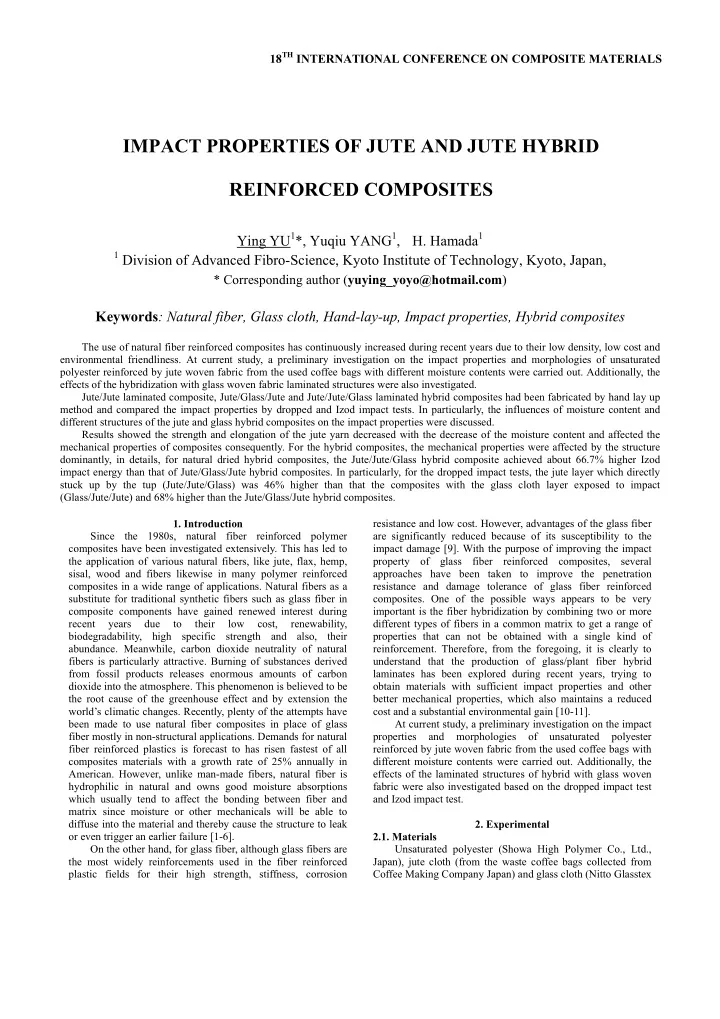

18 TH INTERNATIONAL CONFERENCE ON COMPOSITE MATERIALS IMPACT PROPERTIES OF JUTE AND JUTE HYBRID REINFORCED COMPOSITES Ying YU 1 *, Yuqiu YANG 1 , H. Hamada 1 1 Division of Advanced Fibro-Science, Kyoto Institute of Technology, Kyoto, Japan, * Corresponding author ( yuying_yoyo@hotmail.com ) Keywords : Natural fiber, Glass cloth, Hand-lay-up, Impact properties, Hybrid composites The use of natural fiber reinforced composites has continuously increased during recent years due to their low density, low cost and environmental friendliness. At current study, a preliminary investigation on the impact properties and morphologies of unsaturated polyester reinforced by jute woven fabric from the used coffee bags with different moisture contents were carried out. Additionally, the effects of the hybridization with glass woven fabric laminated structures were also investigated. Jute/Jute laminated composite, Jute/Glass/Jute and Jute/Jute/Glass laminated hybrid composites had been fabricated by hand lay up method and compared the impact properties by dropped and Izod impact tests. In particularly, the influences of moisture content and different structures of the jute and glass hybrid composites on the impact properties were discussed. Results showed the strength and elongation of the jute yarn decreased with the decrease of the moisture content and affected the mechanical properties of composites consequently. For the hybrid composites, the mechanical properties were affected by the structure dominantly, in details, for natural dried hybrid composites, the Jute/Jute/Glass hybrid composite achieved about 66.7% higher Izod impact energy than that of Jute/Glass/Jute hybrid composites. In particularly, for the dropped impact tests, the jute layer which directly stuck up by the tup (Jute/Jute/Glass) was 46% higher than that the composites with the glass cloth layer exposed to impact (Glass/Jute/Jute) and 68% higher than the Jute/Glass/Jute hybrid composites. 1. Introduction resistance and low cost. However, advantages of the glass fiber Since the 1980s, natural fiber reinforced polymer are significantly reduced because of its susceptibility to the composites have been investigated extensively. This has led to impact damage [9]. With the purpose of improving the impact the application of various natural fibers, like jute, flax, hemp, property of glass fiber reinforced composites, several sisal, wood and fibers likewise in many polymer reinforced approaches have been taken to improve the penetration composites in a wide range of applications. Natural fibers as a resistance and damage tolerance of glass fiber reinforced substitute for traditional synthetic fibers such as glass fiber in composites. One of the possible ways appears to be very composite components have gained renewed interest during important is the fiber hybridization by combining two or more recent years due to their low cost, renewability, different types of fibers in a common matrix to get a range of biodegradability, high specific strength and also, their properties that can not be obtained with a single kind of abundance. Meanwhile, carbon dioxide neutrality of natural reinforcement. Therefore, from the foregoing, it is clearly to fibers is particularly attractive. Burning of substances derived understand that the production of glass/plant fiber hybrid from fossil products releases enormous amounts of carbon laminates has been explored during recent years, trying to dioxide into the atmosphere. This phenomenon is believed to be obtain materials with sufficient impact properties and other the root cause of the greenhouse effect and by extension the better mechanical properties, which also maintains a reduced world’s climatic changes. Recently, plenty of the attempts have cost and a substantial environmental gain [10-11]. been made to use natural fiber composites in place of glass At current study, a preliminary investigation on the impact fiber mostly in non-structural applications. Demands for natural properties and morphologies of unsaturated polyester fiber reinforced plastics is forecast to has risen fastest of all reinforced by jute woven fabric from the used coffee bags with composites materials with a growth rate of 25% annually in different moisture contents were carried out. Additionally, the American. However, unlike man-made fibers, natural fiber is effects of the laminated structures of hybrid with glass woven hydrophilic in natural and owns good moisture absorptions fabric were also investigated based on the dropped impact test which usually tend to affect the bonding between fiber and and Izod impact test. matrix since moisture or other mechanicals will be able to diffuse into the material and thereby cause the structure to leak 2. Experimental or even trigger an earlier failure [1-6]. 2.1. Materials On the other hand, for glass fiber, although glass fibers are Unsaturated polyester (Showa High Polymer Co., Ltd., the most widely reinforcements used in the fiber reinforced Japan), jute cloth (from the waste coffee bags collected from plastic fields for their high strength, stiffness, corrosion Coffee Making Company Japan) and glass cloth (Nitto Glasstex
Recommend
More recommend